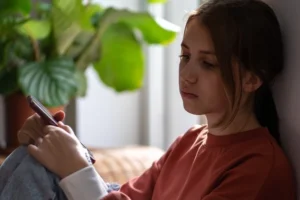Missing knowledge about children’s ability
Interviewees described the importance of image and identity online and how children, ‘just want to be important and relevant and powerful and somebody.’ Despite these sensitive insights by participants, knowledge was poor regarding online risks and harms, and how they might impact vulnerable children and young people. Participants claimed that some carers underestimate young people’s capacity to even go online, particularly those with SEN who can progress their digital skills more rapidly than carers expect.
Challenges with identifying internal constructs, as well as the array of definitions of online vulnerability used by participants, suggests a significant risk of children falling through the gaps:
‘We don’t even get access to those young people unless they’re acting out or look different, so we’re missing the child who carries on OK at school holding it together.’
Taking devices away
A recurrent theme when monitoring online activities, was taking phones away from children and the complexities around this. It could lead to a child losing a source of support and becoming isolated from social life. They could feel their identity was lost. There are additional challenges for foster carers or residential workers in confiscating phones, for instance if purchased by a birth parent, resulting in legal complexities about ownership and carers’ responsibilities.
Fear of being blamed
A particular concern was the culture of victim blaming: ‘Children are fearful of being honest, hiding what has happened because parents demonise that. And another said: ‘I think one of the greatest dangers of children’s vulnerability online is the fact that they’re punished for it.’
Lack of awareness around tech
The generational gap was illustrated by adults’ lack of awareness and being tech averse: ‘I totally avoid anything to do with tech.’ Although participants said there were ‘pockets of a few professionals who do have a good understanding’, they also felt that: ‘GPs were completely not aware’. Foster carers and social workers were said to be ‘woefully unprepared and lacking in knowledge about internet safety.’
Inconsistencies in knowledge, data and assessment
Participants identified gaps in knowledge within their services, as well as a discrepancy in perceptions of risk between children and adults. These gaps are sustained by a lack of data and assessment tools: ‘I don’t think we’re always asking the right questions.’ Others mentioned inconsistent collaboration and communication, particularly around online risks: ‘I guess from my experience multi-agency working around online is really poor’ and ‘kids fell through the net the whole time.’ They mentioned staff turnover and understaffing, with people struggling to keep up, not having services to refer on to and unsuccessful attempts to raise concerns. But a root cause of poor agency collaboration was data which was ‘not routinely collated and analysed.’
Limits to referrals for vulnerable children
Difficulties of cross-agency working were also maintained by the concept of referral thresholds and premature discharge, relying on young people to engage: ‘We’ve built this really defensive system where it’s about thresholds. ‘Do you tick a box, do you not?’ and if [young people] don’t show up for so many appointments, they’re just struck off.’ While positive data sharing existed from a contextual safeguarding and police mapping standpoint, other challenges in data sharing were perpetuated by outdated systems: ‘Some systems can’t speak to each other’.
Digital factors omitted to get a child placed
There were serious concerns about information being omitted by choice, so as not to detract from primary concerns. or due to pressures to get children placed: ‘Digital is not always included even if other professionals around the child know there are digital issues.’ Worryingly, cases with digital elements might result in additional difficulties in finding placements and ultimately, poorer outcomes.
Lack of assessments for digital life
Most importantly, there was a ‘glaring gap’ in the assessment of children. Most assessment tools in use did not include digital life. There is limited routine enquiry regarding online risk: ‘it is insufficiently built into procedures,’ and ‘depends on how switched on the social worker, the team is. It doesn’t feel yet for me, integrated into practice.’
There was a sense of an urgent need for change, ‘Right now there is no data and tools are too generic, not specialised’ and the data ‘is within case notes and only shared if trying to prove a hypothesis and doing dip sampling.’
During the Covid-19 pandemic, there is evidence that young people were at increased risk of harm online and incidents of online child abuse rose markedly. Change is needed. If not now, when?





